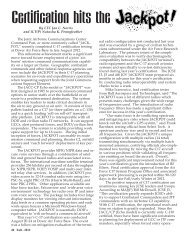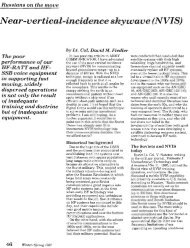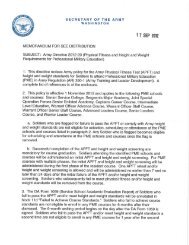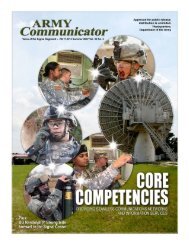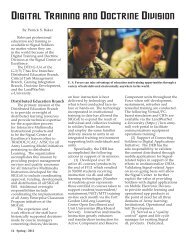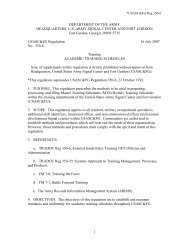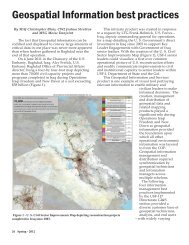AC Summer 08 WIN-T Online - United States Army Signal Center of ...
AC Summer 08 WIN-T Online - United States Army Signal Center of ...
AC Summer 08 WIN-T Online - United States Army Signal Center of ...
You also want an ePaper? Increase the reach of your titles
YUMPU automatically turns print PDFs into web optimized ePapers that Google loves.
Initial NCW Radio<br />
Implementation (MPM-1000<br />
modem plus two different OTM<br />
antennas, one for POP and TCN<br />
and one for SNE).<br />
platforms as well, maximizing<br />
frequency reuse for this tier. This<br />
frequency reuse is automated, with<br />
no user involvement required and is<br />
dynamic to support OTM operation.<br />
c. Demand Assigned User<br />
Data. The HNW assigns timeslots<br />
based on user demand. More<br />
timeslots for that link are assigned<br />
when demand increases at a specific<br />
node. When demand decreases at a<br />
specific node, less timeslots are used<br />
for that link, leaving these timeslots<br />
to be used by other nodes. This<br />
demand assignment feature allows<br />
bandwidth sharing across the<br />
network, optimizes network<br />
throughput, and minimizes spectrum<br />
required.<br />
d. Variable Bandwidths.<br />
HNW networks can be set up in<br />
scarce spectrum environments. It<br />
includes selectable channel bandwidths<br />
<strong>of</strong> 3.125, 6.25, 12.5, 25 and 50<br />
MHz. This allows connectivity and<br />
throughput for an entire tactical<br />
deployment even with limited<br />
spectrum availability.<br />
e. Self-forming and Selfhealing<br />
Network. The HNW<br />
supports mobile ad hoc networking<br />
by automatically discovering and<br />
tracking moving nodes. The HNW<br />
differs from many ad hoc networking<br />
waveforms in that it is designed<br />
to operate with an antenna that<br />
supports narrow beam directional<br />
functionality. To support this form<br />
<strong>of</strong> ad hoc networking, the HNW<br />
includes a Time Division Duplex<br />
TDMA protocol that schedules<br />
access to the communications<br />
channel. The TDD TDMA not only<br />
controls the time at which a link<br />
between nodes has access to the<br />
communications channel, but also<br />
controls the direction over which<br />
that link operates. This allows mesh<br />
connectivity to many other nodes<br />
simultaneously and supports a<br />
robust network. A robust network<br />
allows user bits to travel to the<br />
intended network location using the<br />
least number <strong>of</strong> links. This minimizes<br />
spectrum use.<br />
SATCOM waveform<br />
The Network-Centric Waveform<br />
provides OTM and ATH<br />
satellite communications between<br />
users in a full-mesh multi-frequency<br />
time-division multiple access<br />
network. The NCW SATCOM link<br />
provides range extension for the<br />
<strong>WIN</strong>-T WAN backbone network<br />
through the use <strong>of</strong> various<br />
MILSATCOM and commercial<br />
transponded satellites. The <strong>WIN</strong>-T<br />
NCW network leverages C/X/Ku/<br />
Ka bands ATH and Ku/Ka bands<br />
on-the-move. NCW includes<br />
integrated transmission security that<br />
covers both signaling and user<br />
traffic.<br />
NCW uses a network scheduler.<br />
This automatically calculates<br />
optimum connectivity between all<br />
network member terminals in a<br />
mixed network supporting both<br />
OTM and ATH communications.<br />
NCW supports mesh connectivity<br />
between users while OTM, and does<br />
not require a large aperture hub for<br />
operation. Any terminal can act as<br />
network controller, and devolution<br />
to alternate controllers is automatic.<br />
NCW includes very powerful,<br />
dynamic features to maximize<br />
satellite transponder resources. The<br />
features contributing to the efficiency<br />
<strong>of</strong> NCW are described below.<br />
a. Dynamic Throughput.<br />
Member terminals measure performance<br />
in real time and provide this<br />
measure back to the network controller.<br />
This information is used to<br />
determine the modulation and<br />
coding mode the terminal will use.<br />
This provides automated dynamic<br />
throughput adjustment based on<br />
link conditions, allowing the use <strong>of</strong><br />
the available link margin to support<br />
additional throughput. This means<br />
that the link continues to work at<br />
reduced throughput when traditional<br />
satellite communications links<br />
would break.<br />
b. Demand Assigned. The<br />
TDMA structure <strong>of</strong> the waveform is<br />
used to assign timeslots to terminals.<br />
Only a limited number <strong>of</strong> timeslots<br />
are assigned to a specific terminal,<br />
when little or no throughput is<br />
required. This leaves timeslots<br />
available for other terminals.<br />
When additional throughput is<br />
required, additional timeslots are<br />
assigned. This allows for the sharing<br />
<strong>of</strong> transponder resources across the<br />
network, which optimizes throughput<br />
and minimizes the number <strong>of</strong><br />
satellite transponders that are<br />
required for a given deployment.<br />
Scheduled virtual connections also<br />
provide data to the intended node,<br />
minimizing double hops experienced<br />
in legacy networks and<br />
<strong>Army</strong> Communicator 31



